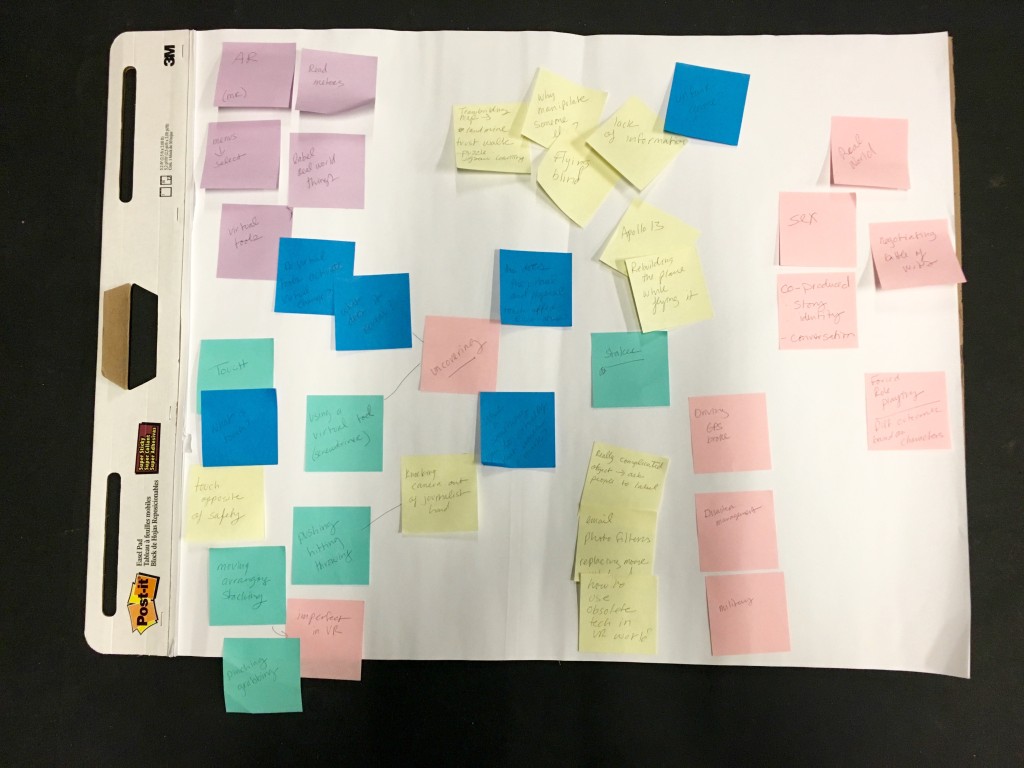Brainstorming, Scenarios, Process: Judeth & Vivek
|
This is a process report on our final project. Much of the project, I believe, is about the trial and error, starts and false starts of designing content for evolving tech. I have never been in this situation. I’ve never had a piece of tech that I then tried to find and design a use for. My first thought was to riff off of something AR is already being used for: instruction. So, I bounced around the idea of making an experience that was a “critical how to.” In a previous blog I looked at some material from destructibles.org, some classics (how to pick a lock, The Anarchists Cookbook), some political propaganda, and some activist-oriented pieces. Next, as a team, we had a brainstorming session. We started with the tech: AR and touch and tried to list the mechanics, affordances and limitations of those things as they stood. Ultimately, we were looking for the overlap between what AR is good for and what touch is good for. We both agreed that “to uncover” might be a good mechanic that might incorporate the hand and using the AR as a window to what lies beneath. This mechanic was potentially inline with the “critical how to” idea.  Top left: mechanics with AR; bottom left: mechanics and limitations of touch; mid: experience; right: connecting experience to life. However, we wondered, if you are manipulating a virtual object overlaid on video feed of the real world, how necessary is the real world? Why wouldn’t it just be a virtual experience? How can we add interaction with the physical object and physical environment? It lead us down the path of thinking about a two-person experiences where one person uses the lenses to see a layer of reality hidden from the other person and must help the second person navigate the world. To help make the idea concrete we listed ways that this experience–when one world has an understanding of the world that other isn’t privy to–occurs naturally, in real life. The next class session I expanded on our brainstorming. As an exercise, I tried to flesh out a possible use scenario for each category of experience we brainstormed. I typed quickly, paying little attention to detail or grammar. I also didn’t tie myself down to the limitations of our current technology (or any technology) instead I tried to let the story unfold and just “made up” the technical functions that I needed to keep the scenario moving. I also wasted no time trying to be original. I did not choose the best example from the category. I chose the most obvious, the most readily available in my mind. The point wasn’t to be brilliant, but just to find a direction. Google Docs – via Iframely After writing these out, as scattered as they were, it got me thinking about writing a series of short “plays” for VR/AR as design fiction. Not a “play,” per se, but still a script, a scenario, based on current technology but not being hampered by it. It might be an interesting way to get at the question posed earlier in the semester: “where is the subtext in VR?” Then we talked with Larry. He was interested in the “man on the street” scenario. We watched Bjork explain television. We discussed the theatre involved in polling folks for their understanding of something like “the internet.” We also discussed using physical props to help someone explain the internet. The most compelling part of the conversation for me was when he asked me if this was a useful methodology for me to pursue. The semester has been a difficult one for me research-wise as I try to define my area of study. I’ve been thinking a lot about methodology. I’ve been thinking about what it means to bring my humanistic background and expertise to system design. I am still an artist. In fact, my greatest strength as a scientist is that I am an artist. As a side project I’ve been developing movement/acting workshops as design probes–getting people up and moving and making together to reveal their values, expectations or mental models related to future technologies. The process is not so dissimilar to what I did on paper–hashing out scenarios not necessarily to design better things, but to understand what expectations and assumptions I have of the experience and/or technology. Time is running out in the semester, but maybe there’s the opportunity to pull some of these threads together. What if… We collected folks mental models of “going viral” or “twitter celebrity,” by piloting a movement/acting workshop that asks folks (folks in this case being people in class and those we can convince to come in) to create going viral in 3-d space and time. Then use the results of the workshop to suggest an AR experience that guides you through “going viral.” The workshop appeals to me over asking random people on campus 1) (IRB) 2) Any materials that I provide to explain the “going viral” will plant a metaphor in someone’s mind, 3) I’m, interested generally in using the body to express thoughts and feelings.
|
